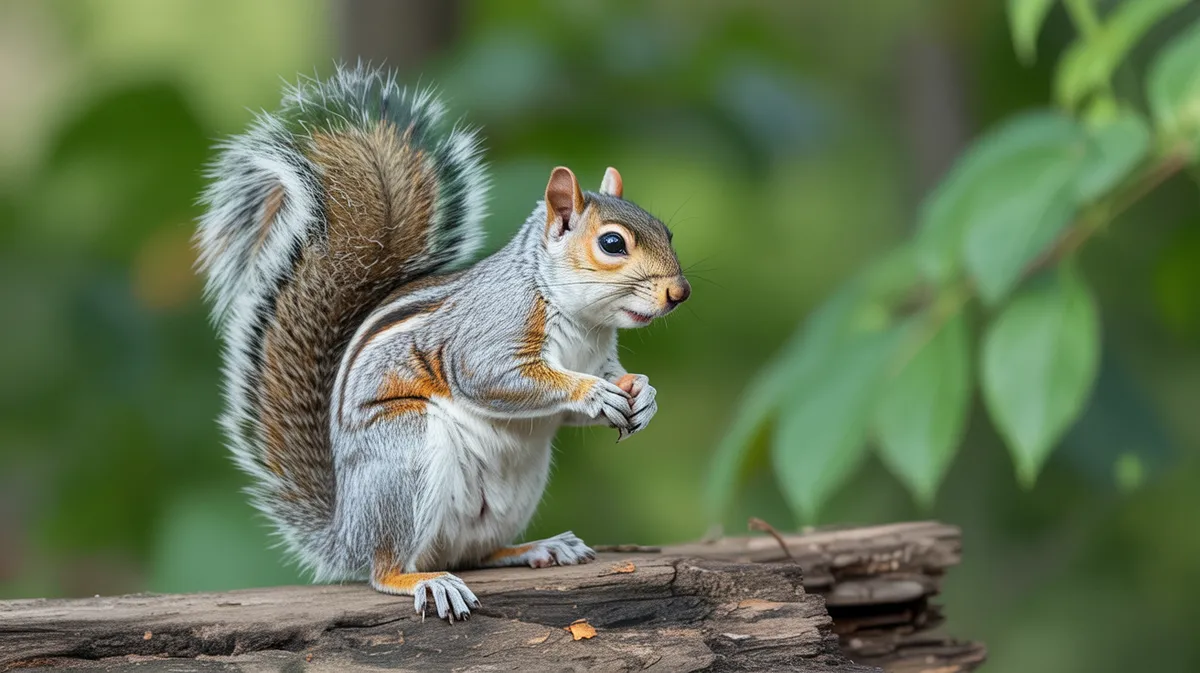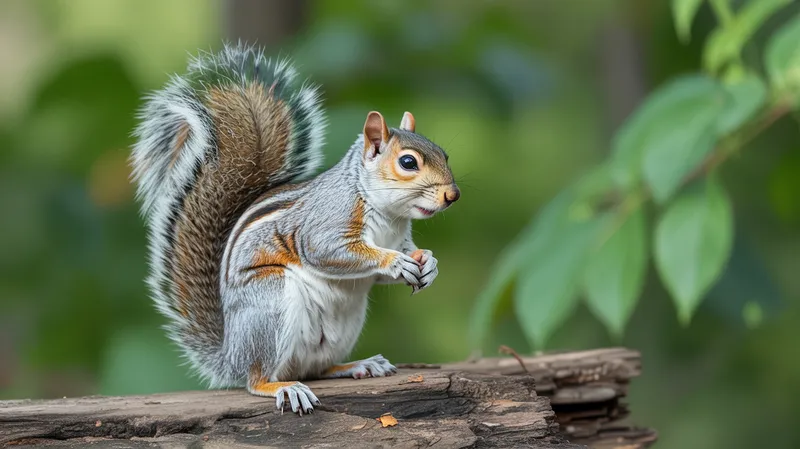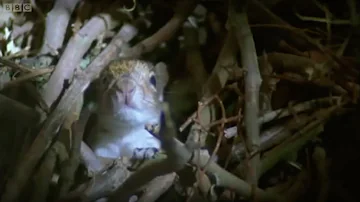
Eastern Gray Squirrel
Sciurus carolinensis

Meet the Eastern Gray Squirrel
The Eastern Gray Squirrel is a medium-sized tree squirrel native to the eastern and midwestern United States, as well as parts of Canada. Recognizable by its predominantly gray fur, bushy tail, and white underbelly, it is a highly adaptable species often seen in both rural woodlands and urban parks. This squirrel is an agile climber and spends much of its time foraging for nuts, seeds, berries, and fungi, which it often buries for later retrieval. Its intelligence and resourcefulness have helped it thrive in diverse environments, making it one of the most common squirrels in North America.
Classification
Mammal
Habitat
Deciduous and mixed forests, urban parks, and suburban areas
Diet
Omnivore
Lifespan
6-12 years in the wild
Conservation
Least Concern
Weight
400–700 grams
📖Fascinating Facts
Food Caching
Eastern Gray Squirrels bury nuts and seeds in multiple locations to store food for winter, often relying on spatial memory to relocate these caches months later.
Tree Acrobat
They are highly agile climbers and can leap distances up to 2 meters between trees, using their tails for balance and steering.
Intelligent Foragers
These squirrels display problem-solving skills and have been observed opening containers and overcoming obstacles to access food.
📋Detailed Description
The Eastern Gray Squirrel (Sciurus carolinensis) is a medium-sized rodent, typically measuring 23–30 cm (9–12 in) in body length with a bushy tail adding an additional 19–25 cm (7.5–10 in). Adults weigh between 400–600 grams (14–21 oz), with males and females being similar in size. Its dense fur is predominantly gray, often with a mix of brownish hues on the back and a white or pale gray underbelly. The tail, used for balance, warmth, and communication, is notably bushy and edged with white. Eastern Gray Squirrels possess sharp, curved claws and strong hind limbs, adaptations that facilitate agile climbing and leaping between branches. Their large eyes provide excellent vision, crucial for detecting predators and navigating complex arboreal environments. They are diurnal, most active at dawn and dusk, and exhibit a high degree of adaptability to urban and suburban settings. The species is known for its intelligence, problem-solving abilities, and complex memory, particularly in relation to food caching. Eastern Gray Squirrels play a vital ecological role as seed dispersers, inadvertently aiding forest regeneration through their scatter-hoarding behavior.
💡 Did you know?
Eastern Gray Squirrels sometimes practice 'deceptive caching,' pretending to bury food to throw off potential thieves.
🔬Research & Sources
Wikipedia Summary
The eastern gray squirrel, also known, outside of the United States, as the grey squirrel, is a tree squirrel in the genus Sciurus. It is native to eastern North America, where it is the most prodigious and ecologically essential natural forest regenerator. Widely introduced to certain places around the world, the eastern gray squirrel in Europe, in particular, is regarded as an invasive species.
Last Modified: 5/29/2025
🎭Behavior & Social Structure
Eastern Gray Squirrels are primarily solitary but may tolerate conspecifics in overlapping home ranges, especially where food is abundant. They are scatter-hoarders, caching thousands of nuts and seeds each autumn in numerous locations, relying on spatial memory and scent to retrieve them. Their diet is omnivorous, consisting mainly of acorns, hickory nuts, walnuts, seeds, buds, berries, fungi, and occasionally insects, bird eggs, and nestlings. Feeding is often accompanied by vigilant behavior; squirrels frequently pause to scan for predators such as hawks, owls, foxes, and domestic cats. Vocalizations include a variety of barks, chatters, and squeals used for alarm, territorial disputes, and communication between mothers and offspring. Scent marking and tail flicking are also important social signals. Daily routines include foraging, grooming, sunbathing, and resting in tree nests (dreys) or tree cavities.
👶Reproduction & Life Cycle
Eastern Gray Squirrels breed twice a year, with peak mating seasons in late winter (January–February) and midsummer (June–July), though timing can vary with latitude. Females are polyestrous and may produce two litters annually if conditions are favorable. After a gestation period of about 44 days, females give birth to litters of 2–5 young (range: 1–8). Neonates are altricial—blind, hairless, and helpless—requiring extensive maternal care. Weaning occurs at 8–10 weeks, after which juveniles begin to explore outside the nest. Females are solely responsible for nest building and rearing young. Sexual maturity is typically reached at 10–12 months. High juvenile mortality is common, with predation and food scarcity as primary causes.
🛡️Adaptations & Survival
Eastern Gray Squirrels exhibit several adaptations for arboreal life, including strong, flexible ankles that can rotate 180 degrees, allowing head-first descent down tree trunks. Their incisors grow continuously, enabling them to gnaw through hard nuts and tree bark. Keen spatial memory and the ability to use landmarks aid in recovering cached food. Seasonal changes in fur density provide insulation against cold winters. They display behavioral plasticity, quickly learning to exploit new food sources and environments, which has facilitated their success in urban landscapes. Their scatter-hoarding strategy not only ensures food supply during lean months but also contributes to forest regeneration.
📚Research Sources
🎨Cultural Significance
Eastern Gray Squirrels are familiar figures in North American parks and gardens, often featured in children's literature, folklore, and as symbols of resourcefulness and adaptability. In some regions, they are hunted for sport and occasionally consumed as game meat. Their presence in urban environments has made them subjects of both affection and irritation, leading to their portrayal in popular culture as clever, sometimes mischievous animals. In the UK, their invasive status has made them a focus of conservation campaigns aimed at protecting native Red Squirrels.
🔬Recent Research & Discoveries
Recent research has focused on the cognitive abilities of Eastern Gray Squirrels, revealing advanced problem-solving skills and episodic-like memory related to food caching. Genetic studies have clarified their phylogenetic relationships within Sciuridae and highlighted the need for taxonomic revision. Investigations into their role as invasive species have examined their impact on native fauna, disease transmission, and ecological dynamics in introduced ranges. Ongoing studies are assessing their adaptability to urbanization, responses to climate change, and interactions with human-modified landscapes.
🎥Wildlife Videos

Eastern Grey squirrel Documentary | All the facts | UK Wildlife
All the facts about the grey squirrel in one documentary. In this Documentary we cover the feeding, breeding, size, colour, agility, ...
Toby Wood

Secrets of Squirrels | Full episode | Animal documentary
Discover how two species of squirrel are being saved from extinction. Explore diverse ecosystems, witness the behavior of ...
WildNature HDTv

Eastern Gray Squirrel - 5 Minute Documentary
Embark on a delightful five-minute journey with a captivating documentary on the Eastern Gray Squirrel, a charming and acrobatic ...
Five Minute Documentaries

Surprising Role of Squirrels in the Ecosystem | SLICE WILD | FULL DOCUMENTARY
With its playful attitude, its shimmering coat, its tasselled ears and its plume-like tail, the red squirrel is easily recognisable.
SLICE Wild

The Wonderful World of Squirrels a Short Documentary | Wildlife Animals | Nature
wildlife #wildanimals #squirrel #beautiful Welcome to Cosmos Therapy! Join us on an enchanting journey into the captivating ...
Cosmos Therapy

Baby Squirrels Nesting | Wildlife On One | BBC Earth
Welcome to BBC EARTH! The world is an amazing place full of stories, beauty and natural wonder. Here you'll find 50 years worth ...
BBC Earth
🌍Habitat Information
The Eastern Gray Squirrel typically inhabits Deciduous and mixed forests, urban parks, and suburban areas environments. Eastern Gray Squirrels have adapted to their environments with specialized features and behaviors.
Primary Habitat:
Deciduous and mixed forests, urban parks, and suburban areas
More detailed habitat information will be available soon.
🛡️Conservation Status
The Eastern Gray Squirrel is currently classified as Least Concern. Conservation efforts are crucial for preserving this species for future generations.
Common Threats:
- 🏠Habitat loss and fragmentation
- 🌡️Climate change impacts
- 🎯Hunting and poaching
- 🏭Human-wildlife conflict
⚠️Threats & Conservation Challenges
While Eastern Gray Squirrels are classified as Least Concern by the IUCN and remain abundant across their native range, they face localized threats from habitat fragmentation, vehicular collisions, disease (notably squirrel poxvirus and mange), and predation. In parts of their introduced range, particularly the UK and Italy, they outcompete native Red Squirrels (Sciurus vulgaris) for food and habitat, and transmit squirrelpox virus, which is lethal to reds but not to grays. In urban areas, they may be considered pests due to damage to gardens, bird feeders, and electrical wiring. Climate change may alter mast cycles and food availability, potentially impacting populations in the future.
🔬Scientific Classification
Scientific Name
Sciurus carolinensis
Classification Hierarchy
🔍 About Taxonomic Classification
Taxonomic classification is a hierarchical system used by scientists to classify and organize living organisms based on shared characteristics and evolutionary relationships.
The system moves from broad categories (Kingdom) to increasingly specific ones, with each animal's scientific name typically consisting of its Genus and species.
📝Community Notes
Share your observations and insights about the Eastern Gray Squirrel with our community of wildlife enthusiasts.
Join Our Community
Sign in to share your observations and connect with fellow wildlife enthusiasts.
Sign In to ContributeNo community notes yet
Be the first to share your observations about the Eastern Gray Squirrel!
Explore Eastern Gray Squirrel
Select a tab above to learn more about this amazing animal.
📸Photo Gallery
No photos available for this animal yet.
🌟Discover More Wildlife
Continue your journey of discovery with more fascinating animals from our database
